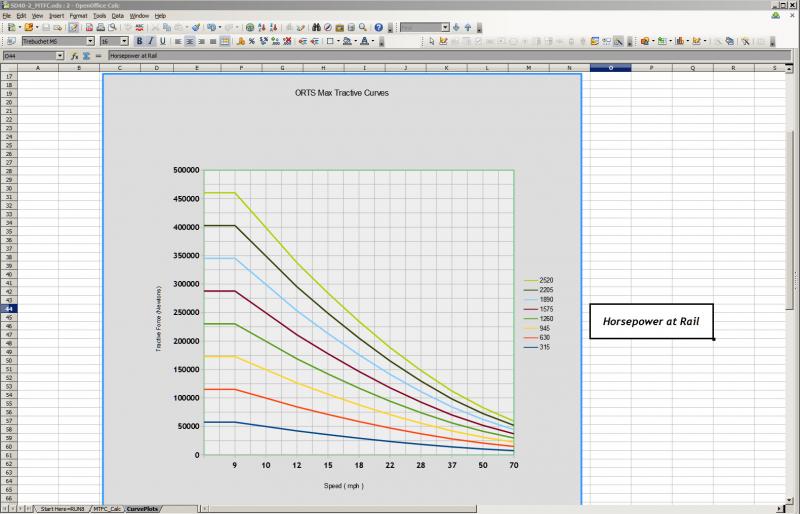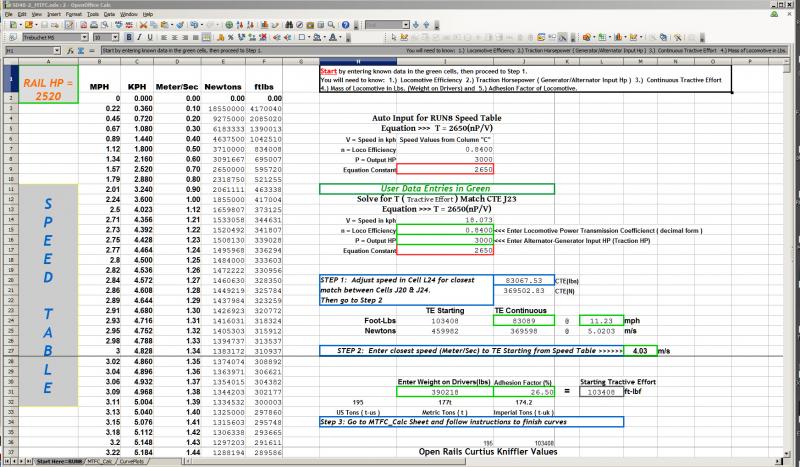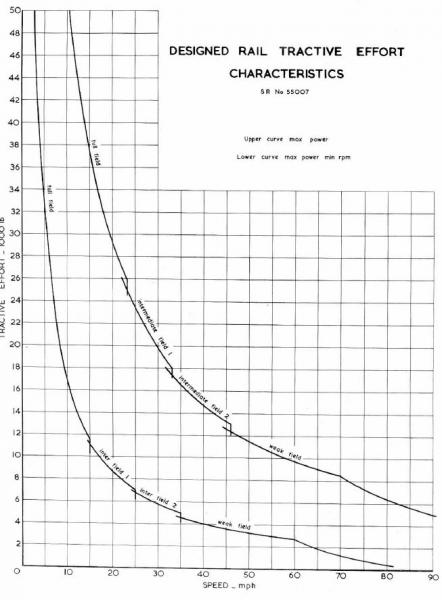Diesel Locomotive Performance
#31

Posted 11 December 2019 - 07:05 PM
#32

Posted 11 December 2019 - 09:20 PM
 edwardk, on 11 December 2019 - 07:05 PM, said:
edwardk, on 11 December 2019 - 07:05 PM, said:
I find the Rail hp by using the efficiency values and Generator\Alternator HP ( traction hp ) --- Bob Boudoin has accurate values as does Derek Morton.
I don't know how OR computes the rail hp from available data. I believe it is shown in the loco HUD, although I'm not sure which value is used...Peter Newell would know. I do know that I use it to calculate the ORTS Max Tractive Curves. I'm working on a version 2 of the Std Engine files ( version 1 was used in the conversion kits available at TS - which I think you are referring to "SLI's Mactier"). Attached is a sample of version 2 for the SD40-2, power ratings are given in the comments section. Also attached is the spreadsheet used to calculate the max tractive curves.
Comment ( VER2 Standard ORTS Diesel Engine for EMD SD40-2 & SD40T2, and safety cab "W" model ) Comment ( Data from Bob Boudoin Engine physics and Derek Morton Train physics ) Comment ( ORTSCurtius_Kniffler ( 9.429 90.537 0.161 0.7 ) ) Comment ( Power Ratings == Gross HP 3150 == Traction HP 3000 == Rail HP 2520 ) Comment ( Coninuous Tractive Effort 83089lb @ 11.23mph == 84%eff. == Stating Tractive Effort 103408lb ) Comment ( Mass 390218lbs = 177.0t == metric, Adhesion Factor = 26.5% ) Comment ( Mass×Adhesion Factor = Starting Tractive Effort ) Comment ( Brake HP -- bhp = Power-at-the-shaft = Gross HP or MaximalPower ) Comment ( Traction HP = Alternator/Generator Input HP ) Comment ( Gross HP per technical specs or lacking good data == add 130hp to 150hp to Traction HP ) Comment ( include ( "..\\..\\Common.inc\\Locomotives\\Std_Eng_SD40-2.inc" ) ) ORTSDieselEngines ( 1 Diesel ( IdleRPM ( 255 ) MaxRPM ( 904 ) StartingRPM ( 155 ) StartingConfirmRPM ( 305 ) ChangeUpRPMps ( 84 ) ChangeDownRPMps ( 53 ) RateOfChangeUpRPMpSS ( 13 ) RateOfChangeDownRPMpSS ( 8 ) MaximalPower ( 2348955W ) IdleExhaust ( 1.2 ) MaxExhaust ( 2.2 ) ExhaustDynamics ( 1.6 ) ExhaustDynamicsDown ( 0.8 ) ExhaustColor ( 20161819 ) ExhaustTransientColor ( 40212324 ) DieselPowerTab ( 0 0 318 293806 402 587612 486 880672 570 1174478 654 1468283 738 1762089 822 2055149 904 2348955 ) DieselConsumptionTab ( 0 0 255 19.7 904 622.3 ) ThrottleRPMTab ( 0 255 12.5 318 25 402 37.5 486 50 570 62.5 654 75 738 87.5 822 100 904 ) DieselTorqueTab ( 0 0 318 70534 402 55795 486 46152 570 39350 654 34296 738 30393 822 27287 904 24812 ) MinOilPressure ( 30psi ) MaxOilPressure ( 90psi ) MaxTemperature ( 120degc ) Cooling ( 3 ) TempTimeConstant ( 720 ) OptTemperature ( 71degc ) IdleTemperature ( 55degc ) ) ) ORTSEmergencyCausesThrottleDown ( 0 ) ORTSWheelSlipCausesThrottleDown ( 0 ) ORTSMainResChargingRate ( 0.4psi/s ) ORTSBrakePipeChargingRate ( 200psi/s ) ORTSEngineBrakeReleaseRate ( 38psi/s ) ORTSEngineBrakeApplicationRate ( 34psi/s ) ORTSBrakePipeTimeFactor ( 0.003 ) ORTSBrakeEmergencyTimeFactor ( 0.1 ) ORTSBrakeServiceTimeFactor ( 1.009 ) TrainPipeLeakRate ( 0.0833psi/s ) TrainBrakesControllerMaxReleaseRate ( 10psi/s ) MaxForce ( 460298N ) MaxContinuousForce ( 369598N ) ORTSMaxTractiveForceCurves ( 0 ( 0 0 4.03 0 4.65 0 5.50 0 6.53 0 7.91 0 9.83 0 12.52 0 16.54 0 22.35 0 31.29 0 ) 0.125 ( 0 57538 4.03 57538 4.65 49875 5.50 42170 6.53 35527 7.91 29305 9.83 23577 12.52 18525 16.54 14019 22.35 10374 31.29 7410 ) 0.25 ( 0 115075 4.03 115075 4.65 99749 5.50 84340 6.53 71054 7.91 58609 9.83 47154 12.52 37050 16.54 28038 22.35 20748 31.29 14820 ) 0.375 ( 0 172612 4.03 172612 4.65 149623 5.50 126510 6.53 106581 7.91 87914 9.83 70731 12.52 55574 16.54 42056 22.35 31122 31.29 22230 ) 0.50 ( 0 230149 4.03 230149 4.65 199497 5.50 168680 6.53 142107 7.91 117218 9.83 94308 12.52 74099 16.54 56075 22.35 41496 31.29 29640 ) 0.625 ( 0 287687 4.03 287687 4.65 249371 5.50 210850 6.53 177634 7.91 146523 9.83 117885 12.52 92624 16.54 70094 22.35 51869 31.29 37050 ) 0.75 ( 0 345224 4.03 345224 4.65 299245 5.50 253020 6.53 213161 7.91 175827 9.83 141461 12.52 111148 16.54 84112 22.35 62243 31.29 44460 ) 0.875 ( 0 402761 4.03 402761 4.65 349119 5.50 295190 6.53 248687 7.91 205132 9.83 165038 12.52 129673 16.54 98131 22.35 72617 31.29 51869 ) 1.0 ( 0 460298 4.03 460298 4.65 398993 5.50 337360 6.53 284214 7.91 234436 9.83 188615 12.52 148198 16.54 112150 22.35 82991 31.29 59279 ) )
#33

Posted 12 December 2019 - 01:20 AM
Thus I believe that the key parameters in defining the power of a diesel locomotive are:
MaxForce - starting tractive effortMaxContinuousForce - maximum sustainable force at speed x.
ORTSSpeedOfMaxContinuousForce - speed at which maximum force is measured.
MaxPower - maximum power that is created at the above two conditions. (Also Rail Power)
The MaxPower can be calculated by the formula - HP = Cont Force (lbf) x Speed (mph) / 308 - at the above point
These values should be reasonably readily available from the Internet.
By default OR calculates the Tractive Force based upon the above parameters. Based upon my review (so far) it appears to match the HP curve reasonably closely.
Attached is a test report graph for the Tractive Force of a BR diesel. Notice the drop off in force at higher speeds.
I believe that it is only worth the effort in generating tractive force curves when one wishes to model this drop off effect, or one has a manufacturers set of curves, otherwise the OR calculations should be close enough.
#34

Posted 12 December 2019 - 03:45 AM
Edit: Should MaxPower() be included in the OR files since both MaxForce() and MaxContinuousForce() are included?
#35

Posted 12 December 2019 - 09:31 AM
 steamer_ctn, on 12 December 2019 - 01:20 AM, said:
steamer_ctn, on 12 December 2019 - 01:20 AM, said:
The question is: How does OR calculate tractive force curves? What parameters are used in the calculations? Otherwise, why have the option in the manual to use ORTSMaxTractiveCurves, if it has no use.
#36

Posted 12 December 2019 - 12:25 PM
 edwardk, on 12 December 2019 - 03:45 AM, said:
edwardk, on 12 December 2019 - 03:45 AM, said:
I believe that it should be used, as it appears to set an upper limit for the amount of force generated by the locomotive, however I haven't fully completed any detailed testing to confirm this.
 R H Steele, on 12 December 2019 - 09:31 AM, said:
R H Steele, on 12 December 2019 - 09:31 AM, said:
In ADVANCED mode (ie with Traction Curves defined), the user is able to customise the shape of the force curve.
So for example, the curves shown in the earlier post are for a diesel with a maximum velocity of 90mph, and as can be seen from the curves, the tractive force starts decreasing below the "smooth" curve that would be generated in the BASIC mode once the speed rises above approx 60 or 70mph, depending upon the throttle setting. So the value of the tractive force curves is its ability to model actual force curves where they are known from test results or specifications.
As an exercise, it would be interesting to plot the two curves on a spreadsheet, and compare the difference.
#37

Posted 12 December 2019 - 08:09 PM
#38

Posted 14 December 2019 - 06:00 PM
So in order to (hopefully) assist users to identify these types of issues, I have added some code (in latest unstable version - post 14/12) to provide some "error" messages. The error messages will advise the value that are "missing" and what value has been set.
These messages by default will only appear if they are "activated", which can be done by ticking the "Verbose ENG/WAG configuration messages" on the "Data Logger" TAB.
This is still a work in progress.
#39

Posted 14 December 2019 - 08:30 PM
 steamer_ctn, on 14 December 2019 - 06:00 PM, said:
steamer_ctn, on 14 December 2019 - 06:00 PM, said:
This is still a work in progress.
Thank you!
Might it be possible to do the same for some of the other new features you've added? Its very hard to figure out what's wrong when something important is missing from the .wag or .eng and only a subset of the parameter data is presented in the f5 screens.
#40

Posted 14 December 2019 - 11:50 PM
 Genma Saotome, on 14 December 2019 - 08:30 PM, said:
Genma Saotome, on 14 December 2019 - 08:30 PM, said:
I perceived that this code would be for key parameters that would stop the diesel from running, otherwise there would be too many different combinations.
To confirm that all "relevant" parameters are included I would still prefer to see a well structured ENG file using some of the formatting that I have suggested in other threads.

 Log In
Log In Register Now!
Register Now! Help
Help







